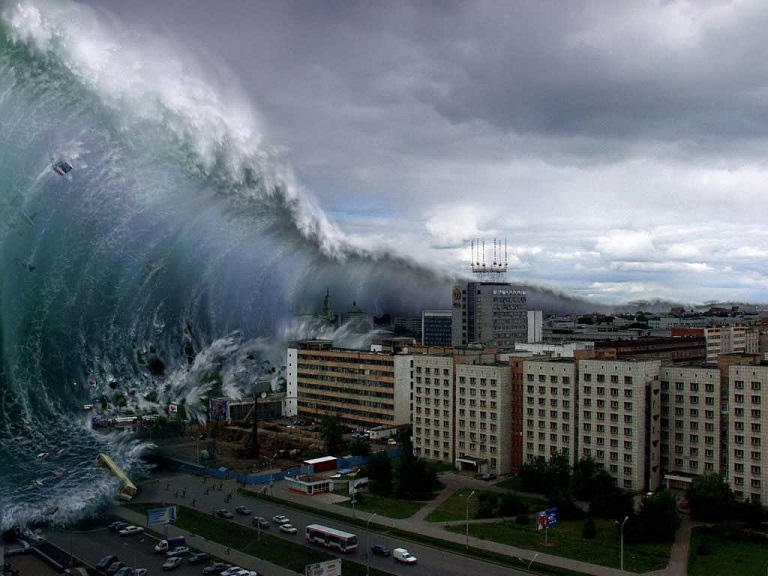The impacts of climate change are already being witnessed around the world. As a city comprised primarily of islands, Hong Kong is now tasked with addressing the predicted impact that climate change, rising sea levels and resulting storm surges will have upon the city. Professor Alexis K H Lau from Hong Kong University of Science & Technology Division of Environment addresses some of the issues surrounding extreme weather scenarios.

With 263 islands and over 733-kilometres of coastline, Hong Kong is vulnerable to the impacts of climate change, including rising sea levels and resulting storm surges. Also dependent upon the Pearl River Delta for daily supplies of fresh food to the city, Professor Lau states that Hong Kong’s plans to mitigate the effects of storm surges must also address food supply alternatives, the relocation of emergency services and encouraging companies to factor protection measures into office designs.
Victoria Harbour

Current coastal formation and levels around the Pearl River Delta (sea level rise of 0m)
In relation to the impact of rising sea levels in Victoria Harbour, Professor Lau explains that there is a Hong Kong Observatory (HKO) station measuring sea levels located in North Point/Quarry Bay that provides vital and relevant data in relation to this issue.
“If we look at the data, we see that sea levels are higher now than they were 30 years ago. It is quite clear from the data that we are seeing that really extreme sea levels are happening more often now compared to 30 years ago. Basically, Hong Kong now has a 60-year scientific record confirming this fact, so this is data, not just someone’s personal opinion.”
“In terms of sea level rises for Victoria Harbour, the question addresses two issues. People think that if you are looking at even a one-metre sea level rise that it is not going to flood anywhere, but the problem with sea level rises is that it is usually not just sea level rises that we should worry about, but what we call storm surges.”
“There are number of reasons why the total sea level can be a lot higher than the mean sea level, partly because of astronomical tides, the tide variations due to the sun and the moon, which are very predictable. The other is when you have a tropical cyclone around Hong Kong. A tropical cyclone with a strong wind can push the water higher, so very often you see storm surges happening in the early summer timeframe, which actually coincides with the astronomical tides. When these two things act together with strong winds, you can have a sea level rise of not just of half a metre or one metre due to climate change, but it can be 3-4 metres or even higher depending on the particular storm.”

Inundation around the Pearl River Delta caused by a sea level rise of 1m
“So, for example, if you have a lot of coastal property to protect, then you may be satisfied to build a coastal defence catering for a once every 100- or 200-year storm, but you may experience a once every 50-year storm or even once every 20 year storm, and these types of storm, can bring major disaster that is acceptable once every 200 years, but definitely not acceptable if it occurs once every 20 years.”
“HKO has also confirmed that here in Hong Kong sea level rises are happening faster than global sea level rises. It is quite clear that sea levels are rising and that the rate of sea level rise will increase. So, as an engineer, I think that it is obvious that if society is well prepared for any possible impact as a result of rising sea levels, that the recovery process will be a lot easier and smoother to implement than if there is no preparation at all.”
Hong Kong infrastructure
In relation to protecting Hong Kong infrastructure or buildings that have proven to be more vulnerable, Professor Lau explains that some emergency services have already started relocating some services to higher floors.
“If our emergency rooms are flooded as a result of rising sea levels and storm surges, then you have a big problem,” states Professor Lau. “Some hospitals have already started building ramps to enable ambulances to reach an emergency room located on an upper floor in the event of flood.
“There are many things that can be done to prepare for the possible eventuality of a catastrophic flood. Hong Kong is very limited in terms of space, so we cannot afford not to develop some areas simply on the off chance that something may happen every ten years, but we also have to make sure that when it happens that the damage is acceptable e.g. if it is a park that gets flooded that people use for recreational purposes, well, this may inconvenience people for a few days or weeks, but it is still acceptable. If the emergency room at a hospital is flooded and therefore cannot provide needed medical services to the community, then this would be regarded as unacceptable.”
“Hong Kong also has a lot of data centres and these have traditionally been stored below street level,” continues Professor Lau. “However, attitudes are changing and companies are now looking at locating their valuable data resources on higher levels of a building. We are not talking about a massive movement of infrastructure, but we need to be sensible and plan to protect Hong Kong’s infrastructure, emergency services, and water and power resources and for companies to examine and redesign their premises to protect their resources and avoid catastrophic losses in the event of flooding.”

Inundation around the Pearl River Delta caused by a sea level rise of 6m
Professor Lau states that in Hong Kong we already build above the estimated mean sea level in relation to future violent storm effects, whether every 200 years or every 10 years, otherwise the disruption to our daily lives would be huge should such a storm occur.
Pearl River Delta
Professor Lau states that according to the recent Inter-governmental Panel on Climate Change Fifth Assessment Report (AR5), the Pearl River Delta (PRD) because of its high population is identified as one of the most susceptible or vulnerable places from rising sea level threats and people have to do something about it.
“It’s not that we have to relocate people and places, but if the PRD is shut down for 3-4 weeks as a result of flooding, then the impact upon Hong Kong will be immense,” says Professor Lau.
The PRD is lower lying land than Hong Kong. If the PRD was flooded for a month it would drastically effect delivery to Hong Kong of vital food supplies and water and into the future possibly even power services, so we need to consider how to prepare for this. Do we need to make arrangements for other areas to provide emergency supplies to Hong Kong people until flooding has subsided in the PRD and farming and the provision of foodstuffs to Hong Kong can be resumed?”
In relation to whether Hong Kong needs to consider implementing schemes such highrise food production to cater for a scenario such the PRD flooding, Professor Lau states that such a scenario is hypothetical and any possible crisis would presumably not be a long-term situation anyway, so promoting local food production is probably not that feasible.
“However, what we do need to do is to identify multiple locations for housing emergency food supplies that can be easily and readily accessed and distributed to the population.”
“If we can establish locations, preferably high locations, where emergency food supplies can be held in suitable conditions to cater for an eventuality such as the PRD being flooded and basically closed for business for some weeks, then the existence of readily available food supplies for Hong Kong would also confirm that the government is doing everything it can to support the population in a time of need.”
Regional devastation
 Professor Lau states that this is no longer just a hypothetical concern as expressed by scientists. If you watch the news regularly, you see how many places around the region are being flooded.
Professor Lau states that this is no longer just a hypothetical concern as expressed by scientists. If you watch the news regularly, you see how many places around the region are being flooded.
In November 2013, Typhoon Haiyan, one of the strongest typhoons ever recorded struck the Philippines, reeking total devastation and floods that devastated entire communities and resulting in 6,268 deaths.
In 2011, severe flooding impacted Thailand as a result of Tropical Storm Nock ten. spreading through provinces and eventually reaching the mouth of the Chao Phraya, inundating parts of the capital, Bangkok and resulting in 65 of 77 provinces being declared flood disaster zones. Also in 2011, floods impacted Brisbane, Australia, flooding the CBD and basically closing down the city for weeks.
“If you look at the amount of coastal flooding that has occurred over the last 10 years, it is obvious that we must now acknowledge that something must be done to try and address this issue as soon as possible. Forward planning is the key to minimising the impacts of climate change.”
In summary, Professor Lau states that we need to look beyond Hong Kong to the whole region, as we also have a moral obligation to provide emergency assistance to those affected.
“Preparations beforehand, whether in Hong Kong or elsewhere across the region will do a lot to placate the general public and provide them with a sense of security, safe in the knowledge that things like food supplies have been stored well in advance in anticipation of such an event.”











